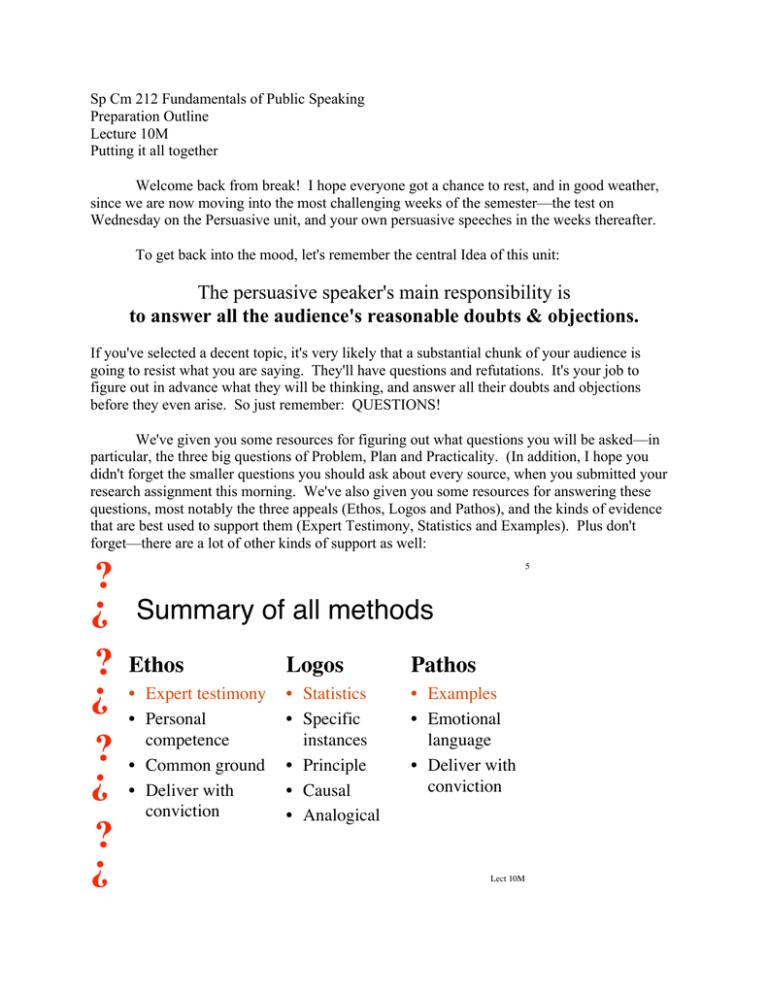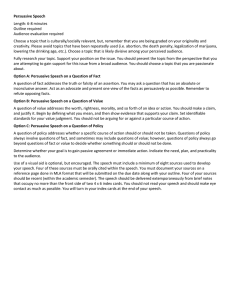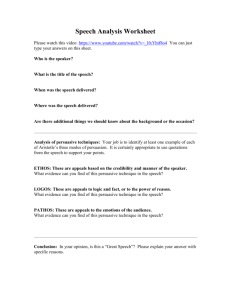Document 10681488
advertisement

Sp Cm 212 Fundamentals of Public Speaking Preparation Outline Lecture 10M Putting it all together Welcome back from break! I hope everyone got a chance to rest, and in good weather, since we are now moving into the most challenging weeks of the semester—the test on Wednesday on the Persuasive unit, and your own persuasive speeches in the weeks thereafter. To get back into the mood, let's remember the central Idea of this unit: The persuasive speaker's main responsibility is to answer all the audience's reasonable doubts & objections. If you've selected a decent topic, it's very likely that a substantial chunk of your audience is going to resist what you are saying. They'll have questions and refutations. It's your job to figure out in advance what they will be thinking, and answer all their doubts and objections before they even arise. So just remember: QUESTIONS! We've given you some resources for figuring out what questions you will be asked—in particular, the three big questions of Problem, Plan and Practicality. (In addition, I hope you didn't forget the smaller questions you should ask about every source, when you submitted your research assignment this morning. We've also given you some resources for answering these questions, most notably the three appeals (Ethos, Logos and Pathos), and the kinds of evidence that are best used to support them (Expert Testimony, Statistics and Examples). Plus don't forget—there are a lot of other kinds of support as well: ? 5 Summary of all methods ? ? Ethos Logos Pathos ? • Expert testimony • Personal competence • Common ground • Deliver with conviction • Statistics • Specific instances • Principle • Causal • Analogical • Examples • Emotional language • Deliver with conviction ? ? ? Lect 10M ? You should probably print out that slide—it'll be very useful for the test. The three sets of three that we've been discussing so far are matters primarily of Invention—coming up with something to say. After adding one final word about Invention, we'll move on to the other tasks in the process of inventing the speech—Memory, Delivery and (especially) Organization. We'll close with a final practice speech analysis, to help prepare you for the test. I. Reply to the opponent's best argument—my final advice about Invention. A. As I've been saying, all of persuasive speaking is about answering doubts and objections. B. You've done your best to answer the audience's main questions. But they probably have some serious objections still in mind. C. Here's the basic rule: At least once, raise the BEST argument against you, and then answer it. This will further assure them that you've taken their views into account, and will give them something to think about. D. When you do this, do not commit the Straw Person fallacy. 1. The Straw Person fallacy is when you mis-state the other side's arguments, and knock down an argument that is weak or even fake—not really what they're saying at all. 2. A Straw Person fallacy persuades no one—instead, it makes you look manipulative. 3. Political debates tend to be dull because both sides engage in Straw Person arguments, accusing each other of holding ridiculous positions. For example, in the immigration debate, one side says "no amnesty" and the other "no isolationism"! But no one is really proposing either amnesty or isolation! 4. So: don't argue against Straw Persons—knock down the best argument against you. II. Use only speaking notes as a Memory aid in order to deliver your speech extemporaneously. A. I saw speeches during the Informative round which were being read or delivered from memory. It's very, very hard to pull this off well—the manuscript gets in between you and the audience. B. The best speaker isn't worrying about him/herself, nor is he/she thinking about her topic. The best speaker is looking at her audience, and conversing with them. C. So put down the manuscript, and use just 5 note cards with key quotes and information, and brief notes in case you get lost (which you won't, if you practice.). III. Release tension before Delivering your speech. A. According to the New York Times, people are paying good money to learn "face yoga." B. The same process of relaxing by tensing can be useful before speeches to put on a friendly face—and I'll give it to you for free. EXERCISE IV. Use a Pattern of Organization suitable for a Persuasive speech. A. Do not use the Topical pattern of organization. 1. When trying to persuade, you're addressing an audience who will likely resist. 2. Therefore, a random collection of appeals will not be enough—your points need to fit together in a much tighter fashion. B. Do use a pattern of organization which allows you to develop your Problem, Plan and Practicality issues. 1. The simplest pattern is Problem/Solution. a. This allows you to develop your Problem in the first point (duh!), and your Solution and Practicality in the Second. b. Check out the sample speeches in the Workbook pp. 61-71 to see what this and the other patterns look like in practice. 2. Also useful is the Problem/Cause/Solution pattern. a. Sometimes the problem is obvious, but the solution isn't. b. For example—right now the farming population is getting older, fast. What's the solution? Well, the first thing you might want to know is what is causing the aging of the population—is it that farmers are afraid to retire, since they don't have any income? is it because land is so expensive? is it because young people don’t want to be farmers? Once you know the cause, then you can easily justify the solution: either an education program for new farmers, retirement benefits for old farmers, low-cost loans for new farmers, whatever! c. So in general: in these situations, the best solution is one that goes to the root cause of the problem, and eliminates it. d. In your speech, therefore, you'll find it useful to separate out the Problem issue into a description of the Problem and a separate analysis of its Cause, before ending with your Solution (combining Plan & Practicality). 3. Finally, Monroe's Motivated Sequence allows you to develop the emotional impact of your speech. 1. Monroes moves your audience from Attention, through basic understanding of Need and Satisfaction, to an emotionally powerful Visualization and a final call for Action. 2. These steps fit easily into a standard speech outline: an attentiongetting Introduction, three points about Problem, Plan & Practicality, and a final return to the Plan in the Conclusion. EXERCISE: sample speech V. Focus on the central tasks of Persuasive Speaking when answering the judgment question on the test. A. As stated on the review sheet (and feedback for the last exam), a good answer uses relevant course concepts, points to specific details in the speech, gives advice about how to improve (if appropriate), is expressed personally from you to the speaker, and most importantly, selects what this speaker most needs to hear, now. B. To remind yourself of what's most important about persuasive speaking, see the assignment sheet and the feedback form in your Workbook C. The simplest advice: focus your answer on the three sets of three: what is most important is going to be Problem, Plan, Practicality, Logos, Ethos, Pathos, Statistics, Expert Testimony, Examples. So before the test on Wednesday, be sure to study using the study guide. Try listening to one of the persuasive speeches on CD #2 that came with your textbook, and answering any of the 20 questions. And note these three specific items: 1. Bring a blue book! 2. If you need extra time on Wednesday—you will have to leave to go to Pearson; there will be a class coming in here immediately after we're done. 3. The Special Occasion unit is going to start before the Persuasive speeches are done. I've cancelled the class on Friday before VEISHEA, but Quiz #7 will still be due online!




